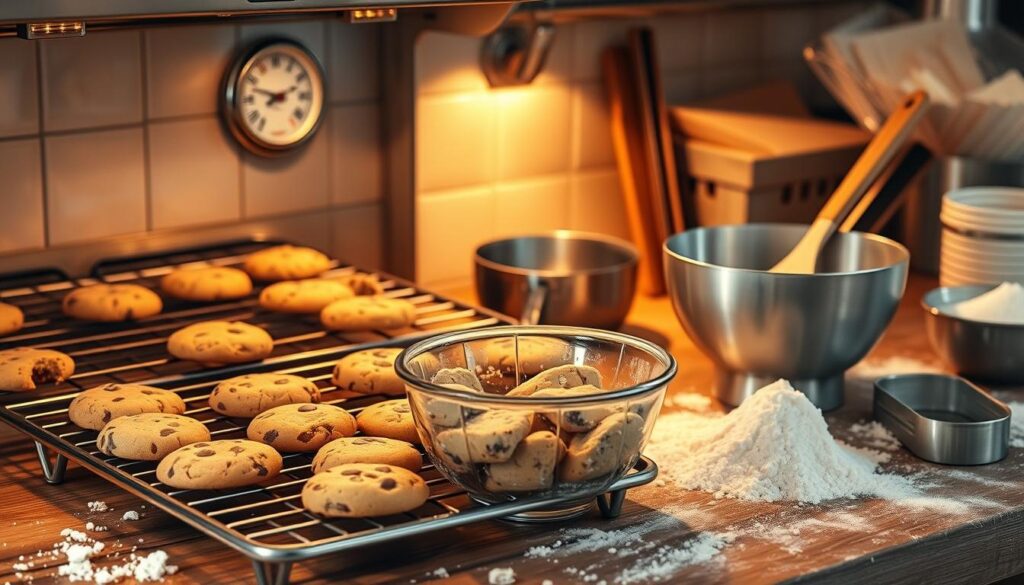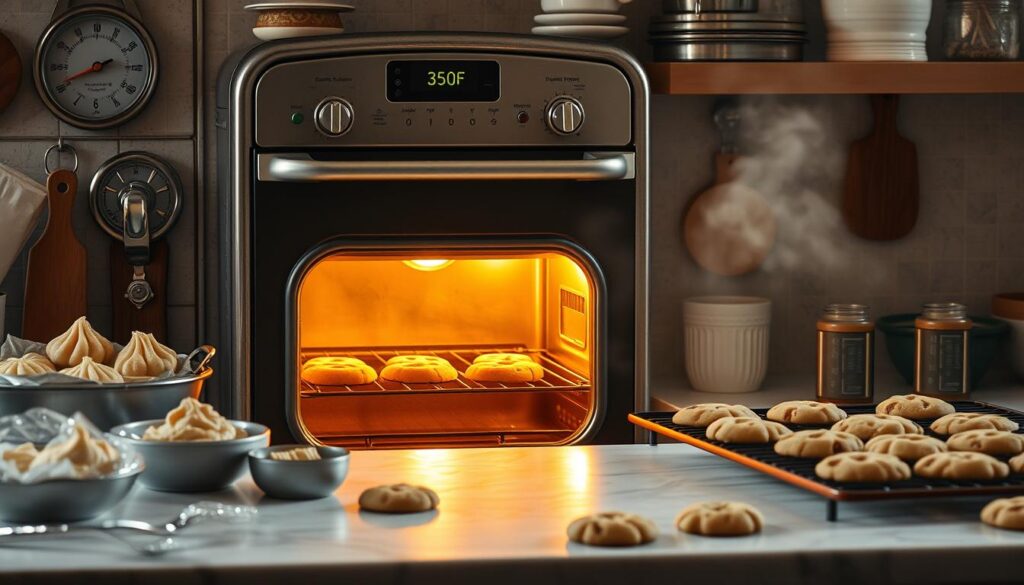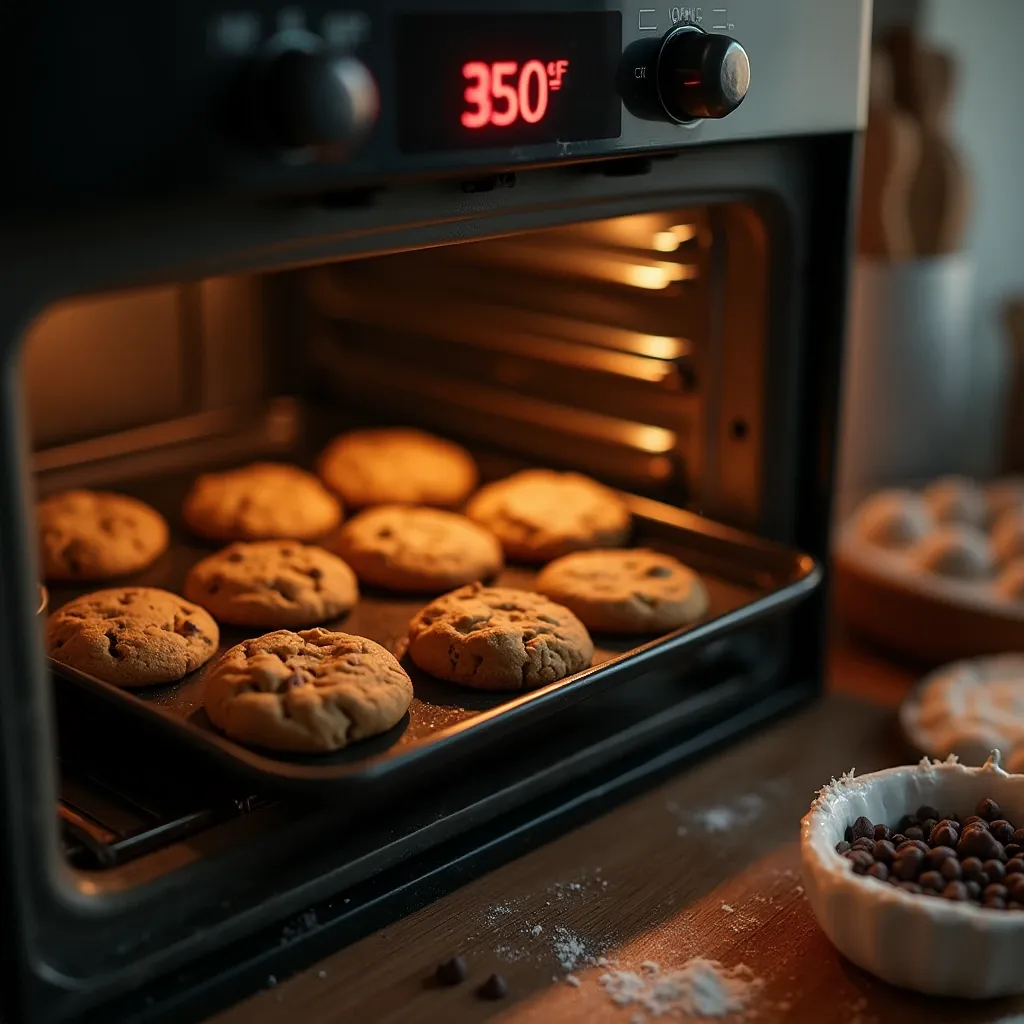Baking temperature is key to making great cookies. Whether you want chewy, crispy, or soft cookies, knowing the right temperature is crucial. This article will help you understand how to choose the best temperature for your cookies.
It covers important factors like oven type, pan material, and classic recipes like the Nestle chocolate chip cookie recipe. By learning about these, you can make your cookies even better.

Key Takeaways
- Correct baking temperature directly impacts cookie flavor and texture.
- Oven type and cookie recipes can alter the ideal baking temperature.
- Understanding cookie types helps in adjusting temperature settings.
- Mastering baking techniques can prevent common mistakes.
- Reputable recipes like Nestle’s offer a solid starting point for bakers.
Understanding Baking Temperatures
Baking cookies is both an art and a science. Knowing the basics of baking temperatures can improve your skills. The right temperature affects how cookies rise, their flavor, and look. It’s all about controlling the chemical reactions that turn dough into tasty cookies.
The Science Behind Baking
Heat makes ingredients in cookies react chemically. Caramelization and the Maillard reaction are key for flavor and color. Keeping the right baking temperature is crucial for these reactions to happen well. Too little heat can stop cookies from rising, while too much can burn them.
How Temperature Affects Texture
Temperature greatly impacts cookie texture. Chewy cookies need higher temperatures for a quick bake. This makes the outside crisp and the inside soft. For crunchy cookies, longer baking times at lower temperatures work best. Trying different temperatures can help you get the texture you want.
| Baking Temperature (°F) | Texture Result | Activated Chemical Reactions |
|---|---|---|
| 325 | Crispy | Slow caramelization |
| 350 | Chewy | Maillard reaction |
| 375 | Soft | Quick baking, less moisture loss |
What Temperature Do You Bake Cookies At?
Finding the right cookie baking temperature is key for the perfect texture and taste. The usual range is 325°F to 375°F (163°C to 191°C). Different cookies react differently to these temperatures, affecting their rise and browning.
At 325°F, cookies spread out more, making them chewier and softer. This temperature is great for thicker cookies, helping them bake evenly without burning the edges. On the other hand, 375°F makes cookies puff up and get crispy, perfect for meringues and fun shapes.
Knowing these temperature details is part of general baking wisdom. Every degree affects the texture, so you might need to tweak based on your oven and recipe. Finding the right balance between temperature and baking time is crucial for perfectly baked cookies.
| Temperature (°F) | Type of Cookie | Texture | Baking Time |
|---|---|---|---|
| 325 | Chewy Cookies | Soft and Tender | 10-12 minutes |
| 350 | Classic Cookies | Balanced | 10-15 minutes |
| 375 | Crispy Cookies | Crunchy and Firm | 8-10 minutes |

Common Cookie Types and Their Ideal Temperatures
Understanding different cookie types and their baking needs is key to success. Each type needs a specific temperature to get the right texture and taste. Here are the best baking temperatures for various cookies.
Chewy Cookies
Chewy cookies are loved for their softness. To get this texture, bake them at 350°F (175°C). This temperature helps them spread right and stay soft inside.
Crispy Cookies
Crispy cookies are all about crunch. Baking them at 375°F (190°C) makes them crispy on the outside and firm inside. This high temperature is key for that perfect snap.
Soft Cookies
Soft cookies need gentle baking. Use a lower temperature, about 325°F (163°C), to keep them moist and tender. This ensures they stay soft and chewy, not dry.
| Cookie Type | Ideal Baking Temperature | Texture Outcome |
|---|---|---|
| Chewy Cookies | 350°F (175°C) | Soft and chewy |
| Crispy Cookies | 375°F (190°C) | Crispy and crunchy |
| Soft Cookies | 325°F (163°C) | Moist and tender |
Try different baking temperatures for each cookie type to find your favorite. Adjust the temperature to make your own special cookies.
Nestle Chocolate Chip Cookie Recipe Overview
The Nestle chocolate chip cookie recipe is a favorite among many. Knowing the key ingredients is crucial for the right taste and texture. Using quality ingredients and the right amounts is key to making perfect cookies.
Ingredients for Success
To make the famous Nestle chocolate chip cookies, you’ll need these ingredients:
- 2 1/4 cups all-purpose flour
- 1/2 teaspoon baking soda
- 1 cup butter, softened
- 1/2 cup granulated sugar
- 1 cup packed brown sugar
- 1 teaspoon salt
- 2 teaspoons pure vanilla extract
- 2 large eggs
- 2 cups Nestle semi-sweet chocolate chips
The base of these cookies is butter, sugars, and eggs. High-quality chocolate chips add to the flavor, making the cookies a hit.
Preparation Tips
Here are some tips to improve your baking with the Nestle chocolate chip cookie recipe:
- Mix the ingredients well to ensure sugar and flour are evenly spread.
- Chill the dough for at least 30 minutes to enhance flavors.
- Scoop the dough onto a baking sheet, leaving enough space for spreading.
- Bake at the recommended temperature and check for doneness for the best cookie texture.
By following these tips, you’ll get cookies that are golden brown and chewy, just like the classic ones.
How to Properly Preheat Your Oven
Preheating your oven is key in cookie baking. It makes sure your cookies start at the right temperature. Without preheating, cookies can bake unevenly, affecting their texture and shape.
Knowing how to preheat your oven right can prevent common mistakes. These mistakes can ruin your favorite cookie recipes.
Importance of Preheating
Starting with a preheated oven is crucial for great results. It lets the dough spread and rise as the recipe wants. If the oven isn’t hot enough, cookies might be too soft or overcooked.
In short, preheating is vital for baking success.
Common Preheating Mistakes
Even experienced bakers can make mistakes when preheating. Here are some common ones to avoid for perfect cookies:
- Not giving the oven enough time to heat up. This can result in undercooked cookies.
- Using a standard thermometer instead of the oven’s built-in gauge. This can give wrong readings.
- Opening the oven door too often. Each time, heat escapes, which can mess up the baking.
By avoiding these mistakes, bakers can improve their cookie baking. A well-preheated oven helps make delicious cookies that everyone loves.
Adjusting Baking Temperatures for Altitude
Baking at high altitudes is tricky because of lower air pressure. This means moisture in cookie dough evaporates faster. Knowing how to adjust for altitude is key for great cookies. Here are the important changes you need to make.
Baking at High Altitude
When baking at high altitudes, you must change both temperature and ingredients. The lower air pressure changes how cookies rise and bake. Without adjustments, they can turn out dry.
Recommended Adjustments
- Lower the baking temperature by 15 to 25 degrees Fahrenheit to prevent overcooking.
- Add a bit more liquid to your cookie dough. This helps combat the rapid moisture loss.
- Include an additional 1 to 2 tablespoons of flour to stabilize the structure.
- Reduce the sugar amount slightly to prevent cookies from spreading too much.
| Altitude (Feet) | Baking Temperature Adjustment (°F) | Sugar Adjustment (%) | Flour Adjustment (tbsp) | Liquid Adjustment (tbsp) |
|---|---|---|---|---|
| 3,000 | -15 | -10 | 1 | 1 |
| 5,000 | -20 | -15 | 2 | 2 |
| 7,000 | -25 | -20 | 3 | 3 |
Using Convection vs. Conventional Ovens
Knowing the difference between convection and conventional ovens is key for baking cookies. Convection ovens use a fan to spread hot air evenly. This leads to even cooking and browning. It also changes how long and at what temperature you bake.
Differences Between Oven Types
Convection and conventional ovens heat differently. Conventional ovens use radiant heat, which can cause hot spots. This might make cookies bake unevenly. On the other hand, convection ovens cook more evenly, making baking more consistent.
Temperature Adjustments for Convection Ovens
When using convection ovens, you need to adjust the temperature. Lower the temperature by 25°F (14°C) to avoid overcooking. This change can make cookies crisper or browner.
| Characteristic | Conventional Ovens | Convection Ovens |
|---|---|---|
| Heat Source | Radiant heat | Circulated hot air |
| Cooking Time | Typical baking times | Shorter baking times |
| Temperature Recommendation | Maintain standard temperature | Reduce temperature by 25°F (14°C) |
| Evenness of Cooking | Possible uneven baking | More even results |
The Role of Cookie Dough Temperature
The temperature of cookie dough is key to making great cookies. Knowing the difference between chilled and room temperature dough helps bakers get the right texture and consistency.
Chilled Dough vs. Room Temperature Dough
Chilled dough makes cookies thicker and chewier. It spreads less in the oven, keeping cookies’ shape better. This makes them look more appealing.
On the other hand, room temperature dough spreads more. This results in thinner cookies that can be crispy and delicate. Choosing the right dough temperature changes how cookies taste and look.
Impact on Baking Time and Texture
The dough’s temperature also affects baking time. Chilled dough needs a bit longer to bake. This makes the cookies chewy with a soft center.
Room temperature dough, however, can make cookies crispier all over. Knowing this lets bakers make cookies just the way they like them.
Testing for Doneness
Getting your cookies just right is key to baking success. Knowing when they’re done can turn a good cookie into a great one. Look for visual signs and use a baking test to get it right.
Visual Cues
Watching for certain signs helps you know if cookies are done. Look for the edges to turn golden. This means the outside is cooking well. The middle should still be a bit soft, showing they’ll bake a bit more after being taken out.
Remember, overcooking can make cookies tough and lose their flavor.
Using a Toothpick Test
A toothpick test is a trusted way to check if cookies are done. Just stick a toothpick into the cookie’s center. If it comes out clean or with a few moist crumbs, they’re ready. If it’s covered in wet dough, bake them a bit longer.
This easy trick helps you get the perfect chewiness and softness in your cookies.
Common Baking Mistakes and How to Avoid Them
Baking cookies can be tricky. Many home bakers face different problems. Knowing the common mistakes helps avoid them and get the right result. Focus on two main areas: avoiding overbaking and underbaking, and using accurate cookie measurements.
Overbaking vs. Underbaking
Getting the right balance between overbaking and underbaking is key for tasty cookies. Overbaking makes cookies dry and crumbly. This happens when baking time is too long or the oven is too hot. On the other hand, underbaking results in cookies that are still gooey in the middle.
Checking cookies often while they bake helps catch them at the perfect time. This ensures they turn out right.
Importance of Accurate Measurements
Accurate measurements are crucial in baking. Even a small mistake in measuring flour or sugar can change the cookie’s taste and texture. Following recipes closely helps achieve consistency.
Using a kitchen scale for measuring ingredients helps avoid mistakes. It leads to better baking results.
Expert Tips for Baking Perfect Cookies
Baking the perfect cookie is more than just following a recipe. Seasoned bakers share tips to help you succeed every time. Using quality ingredients and the right preparation method can make a big difference.
Using Quality Ingredients
Choosing the right ingredients is key. High-grade butter, pure vanilla extract, and premium chocolate make a big impact. Organic flour and fresh eggs add a rich taste that store-bought ingredients can’t match.
Batch Sizes and Spacing
Spacing cookies on your sheet is important for even baking. Too many cookies can cause uneven heat, leading to burnt edges and underbaked centers. Follow expert advice for enough space between cookies for even cooking.
Conclusion
Baking cookies is all about understanding the details. This guide has shown you the best temperatures for different cookies. It also highlighted how dough temperature affects the final taste.
Whether you want chewy, crispy, or soft cookies, knowing the right temperature is crucial. It ensures your cookies turn out delicious.
Using top-notch ingredients and following baking techniques is also vital. A cookie tips summary would say that small changes can make a big difference. So, don’t be afraid to try new things and find what works best for you.
This way, you’ll become a pro at baking cookies. You’ll make treats that everyone will enjoy.
Now that you know more, go ahead and try new recipes. Experiment with different baking methods. This will help you make cookies that are not only tasty but also look great.
FAQ
What temperature should I bake cookies at for the best results?
For most cookies, bake at 325°F to 375°F (163°C to 191°C). Chewy cookies do best at 350°F (175°C). Crispy cookies need 375°F (190°C).
How does baking temperature affect cookie texture?
Baking temperature greatly changes cookie texture. Higher temperatures make cookies crispy. Lower temperatures make them chewy.
Why is preheating the oven necessary?
Preheating ensures cookies bake at the right temperature. This is key for texture and flavor. It helps in baking evenly, avoiding uneven cookies.
What common mistakes should I avoid when baking cookies?
Avoid overbaking and underbaking. These mistakes ruin texture and taste. Accurate measurements and close monitoring of baking times are crucial.
How should I adjust baking temperatures for high-altitude baking?
At high altitudes, lower the temperature by 25°F (14°C). Also, adjust ingredients and baking times due to air pressure changes.
Can I use convection baking for cookies?
Yes, but lower the temperature by 25°F (14°C). Convection ovens cook evenly, improving cookie results.
What should I look for to test if my cookies are done?
Check for golden-brown edges and slightly soft centers. Use a toothpick test; it should come out clean or with a few moist crumbs.
What is included in the Nestle chocolate chip cookie recipe?
The recipe includes butter, brown sugar, white sugar, eggs, flour, baking soda, salt, vanilla, and chocolate chips. Quality ingredients improve flavor and texture.

